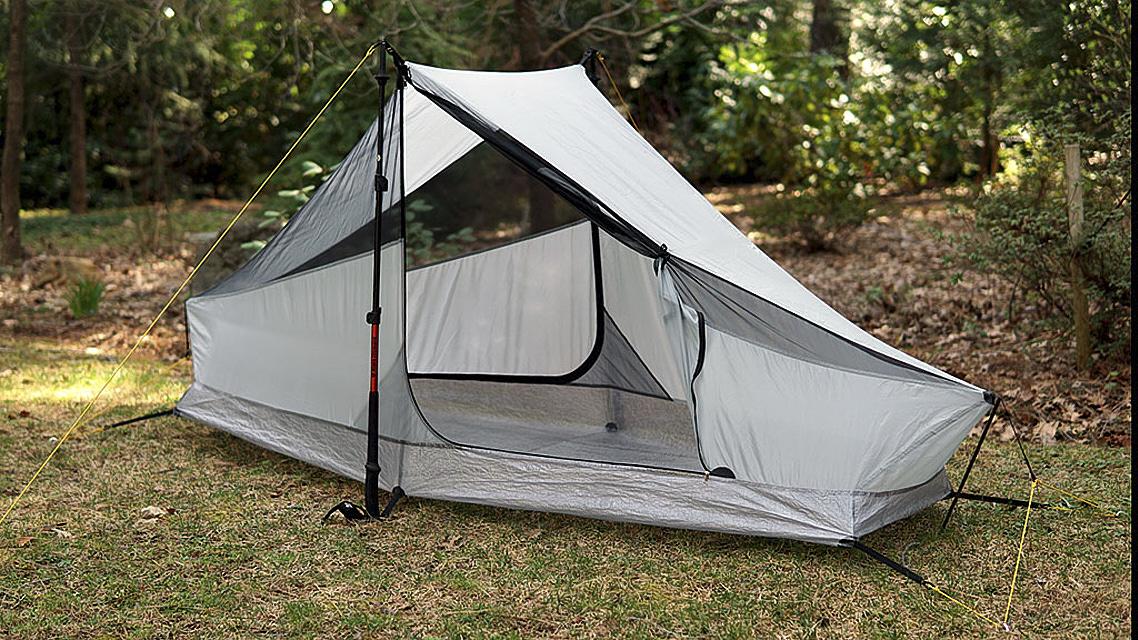Topic
Tarptent Notch Li Review (First Looks)
Forum Posting
A Membership is required to post in the forums. Login or become a member to post in the member forums!
Home › Forums › Campfire › Editor’s Roundtable › Tarptent Notch Li Review (First Looks)
- This topic has 125 replies, 27 voices, and was last updated 9 months, 2 weeks ago by
 Brad W.
Brad W.
-
AuthorPosts
-
Dec 14, 2020 at 9:45 am #3688931
It’s odd…I don’t really mind a slightly smaller space. In a storm I’d take the Notch for all the other advantages. We’re talking about inches.
but I’m only 5’8” and 145 lbs. when I’m in my tent and lying down, I’m either reading or sleeping. I doubt I’d mind the taper. I doubt I’d notice it much. the important thing for me is being able to sit up and move things around, including myself.
It’s true I enjoyed the larger space of my Zpacks Hex solo. I didn’t enjoy not being able to zip it up tight in a storm.
Dec 14, 2020 at 11:27 am #3688954I’m a 6′ tall Silnylon Notch user. 3 Season. Several years.
The only thing that bothers me much is the inner door arrangement (I’d prefer full Tzip or full C shape so I can access all of both vestibules without having to sit up and do a reach around). And the lack of solid fabric roof on the inner so I don’t get a drip in the eye, waking me up sometimes.
Dec 14, 2020 at 12:10 pm #3688965There is one thing: I’m a hiking pole addict. With the zpacks hexamid solo, I got a light dedicated single pole so that I could leave the tent up and go off for a day trip with my hiking poles. I think the dedicated pole only weighed about 3 ounces, so not bad.
The single pole set up on the Aeon would be preferable in this regard.
Nov 18, 2021 at 7:24 am #3732618One huge advantage of the Notch’s shape and size, is the ease of finding a spot to pitch in dense forests and rocky terrain.
Dec 17, 2022 at 7:02 pm #3767954So OK, I didn’t “win the lottery” but i bought a gen. 2 Notch Li.
My UPGRADES: 1.) dyed the inner tent green with RIT Dyemore synthetic dye for shade and privacy and 2.) Using circles or DCF tape then Tenacious Tape for reinforcement wrapped around the fly hem edge I sewed 4 stake loops on the fly hem. Then I attached double elastic hair “circles” to the stake loops foe some “give” in high winds. These stake points are great to cut down flapping on windy days (AND nights).
Dec 17, 2022 at 9:22 pm #3767959Eric… did you dye the netting on the inner? How did that work out?
thanks…
Dec 12, 2023 at 6:05 pm #3795375Does anyone have any decent data on how much warmer the solid inner is vs mesh in relation to ambient temperatures?
Dec 12, 2023 at 6:36 pm #3795376My empirical data from lots of winter camping is that simply having a tent with an outer that pitches tight to the snow gets you a way good head start. Depending on wind hitting the vents, maybe 6-8°F. Adding a fully solid inner can help another 3-4°F. Edit: remember that sealing the tent like that can suffocate you if the vents are not functioning.
Partial mesh inner (as the Notch’s ‘solid’ inner, right?) would obv be a little less, but I feel they are not worth the weight in winter as wind driven fine snow entering thru the vents still ends up covering my stuff
However it all starts with a good outer design. High pitching Duplex styles or basic tarp canopies doesn’t do much. YMMV
I typically go with a small inner-less mid (Khufu) and a loose ground sheet, or step it up all the way to a Hilleberg if the conditions call for it
Dec 12, 2023 at 7:18 pm #3795380“Partial mesh inner (as the Notch’s ‘solid’ inner, right?) would obv be a little less, but I feel they are not worth the weight in winter as wind driven fine snow entering thru the vents still ends up covering my stuff…”
My experience with other tents is that a half solid inner weighs the same as a full mesh inner. Moreover, the wind blockage is significant, or at least I’ve noticed a big improvement. That additionally adds to the added warmth of a half solid inner, as far as I can tell without measurements. One of my gripes with a single wall tent is precisely how cold they feel, compared even to a full mesh double wall tent. But I sleep cold.
Asphyxiating in my tent is the least of my worries. But I understand the valid point: if your tent is pitched flush to snow to stop incoming cold air/winds, then a snow blocked vent could lead to O2 deprivation.
Dec 12, 2023 at 7:26 pm #3795381This recent story is about a trip where I took a Tarptent Notch Li and used the partial solid inner for overnight temps in the teens °F. Inside the tent was only 3 °F warmer than outside the tent. There’s a lot of mesh in that inner tent.
In contrast, temperatures inside my Tarptent Dipole DW 1 are regularly 8-12 °F warmer than outside when outside temps are in the 0 °F to 35 °F range (haven’t tested it outside those ranges yet). The solid inner tent for the Dipole has only two little mesh windows at the top of the doors, much more solid fabric. Also, silpoly canopy (vs. DCF on the Notch Li) and a lower fly pitch help retain heat.
Dec 13, 2023 at 3:26 am #3795418Surprisingly, I found the “solid” inner on the SS li weighs slightly less than the full mesh.
Dec 13, 2023 at 8:57 am #3795435I’m finding these discussions (and data) interesting. I have a Notch (silnylon) and own both inners. I don’t do a lot of winter camping, but when I have, my subjective take on the partial-solid inner is that its wind-blocking is more significant comfort-wise than any direct effect on temperature. Not that I’ve ever done comparative measurements…I wonder how meaningful it would be if it’s breezy enough to force major ventilation. But slowing/stopping the air movement on my face seems worthwhile.
As others have mentioned, you can maybe achieve the same thing by pitching the fly to ground level, but I’ve not had any luck getting the Notch to pitch like that.
Dec 13, 2023 at 9:10 am #3795437Thanks Ryan. I have tried to pitch my Notch Li and Duplex closer to the ground-doesn’t work. Can’t keep the panels all tight. One could shovel snow and build a berm around the perimeter if conditions allow I guess.
Dec 28, 2023 at 10:11 am #3800308@Todd T Have you had the solid inner in a decently breezy/windy condition? I wonder how well that solid blocks wind.
Dec 28, 2023 at 11:09 am #3800318@Todd T Have you had the solid inner in a decently breezy/windy condition? I wonder how well that solid blocks wind.
I spent one night in the tent when it was in the low to mid 20s, with winds up to maybe 20 or 25 mph. I was in a little copse of trees, so I wasn’t taking the full brunt, but the tent was shaking pretty good at times. It certainly seemed to me I was feeling less air movement than would be typical in the full-mesh nest. Subjective, yes.
I’ve never tested it, but I also think the partial-solid inner would be a godsend if there were blowing sand.
Dec 28, 2023 at 11:17 am #3800319Thanks Todd.
Dec 29, 2023 at 9:58 am #3800385I have used both inners in a Notch Li above tree line and found the partial solid inner makes a significant difference in blocking the wind. I tend to keep at least one door open on each side unless weather dictates otherwise. The semi solid inner feels warmer to me but only slightly, so the wind resistance is really the major difference. I like to easily see out at night, something the mesh inner makes a lot easier!
Jan 24, 2024 at 1:14 pm #3802279Was too cold(-12F), for me, to go out last week so I tested the Notch Li in some snow. We got 12-14″ and it did great. I built berms at fly line to stop snow from coming into vestibule. The snow pushed in the vestibule a little but not enough to bother anything I would have had in those areas. Zippers are a bit harder to work at temps below 20F.
Pics https://imgur.com/a/WoWLcir
Now do I get the nylon floored solid inner or dcf?
Jan 24, 2024 at 1:30 pm #3802281I have really grown to love my Notch Li, but not in snow! Hot tent or go home. Great photos though, thanks for sharing!
Jan 24, 2024 at 1:45 pm #3802284nice photos Brad
that shows a problem with sloped sides like a mid – the snow accumulates and pushes in the sides
if you’re inside, you can just push out and the snow will fall away
when there’s snow against the sides the condensation inside can be really bad
Jan 24, 2024 at 1:52 pm #3802286 Jan 24, 2024 at 1:53 pm #3802287
Jan 24, 2024 at 1:53 pm #3802287Yeah, once the snow seals the fly to the ground, the two small vents are just not enough.
Jan 25, 2024 at 11:10 am #3802357Just to clear up any confusion, the original Notch “partial solid” interior had partial solid sidewalls and mesh roof panels. These days the “solid” interior has roof panels which are solid. Here is a photo of the Li version and the silnylon version has the same design.
-H
 Jan 25, 2024 at 12:50 pm #3802367
Jan 25, 2024 at 12:50 pm #3802367@Henry Shires Thanks. Is there any advantage to solid roof? Also, is there any advantage except for small weight savings in the DCF floored solid vs silnylon floored solid?
Jan 25, 2024 at 12:59 pm #3802368In comparison to the prior mesh roof, the solid roof version is warmer and slightly lighter. To the extent that any condensation droplets gets knocked off the underside of the fly by gusty wind or rain the solid material also better blocks it from reaching the occupant. As for flooring, both materials have upsides and downsides. Plus for nylon is the lower cost, increased longevity, and better puncture/abrasion resistance. Plus for Dyneeema is the slightly lighter weight and full water non-absorption.
-
AuthorPosts
- You must be logged in to reply to this topic.
Forum Posting
A Membership is required to post in the forums. Login or become a member to post in the member forums!
BASECAMP LIVE FALL ’24 enrollment now open – LEARN MORE
Our Community Posts are Moderated
Backpacking Light community posts are moderated and here to foster helpful and positive discussions about lightweight backpacking. Please be mindful of our values and boundaries and review our Community Guidelines prior to posting.
Get the Newsletter
Gear Research & Discovery Tools
- Browse our curated Gear Shop
- See the latest Gear Deals and Sales
- Our Recommendations
- Search for Gear on Sale with the Gear Finder
- Used Gear Swap
- Member Gear Reviews and BPL Gear Review Articles
- Browse by Gear Type or Brand.





